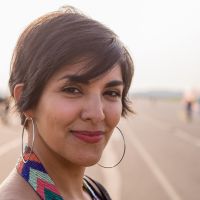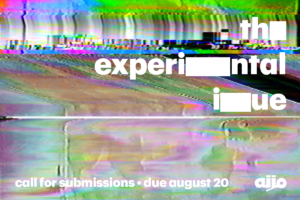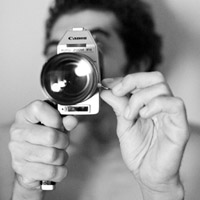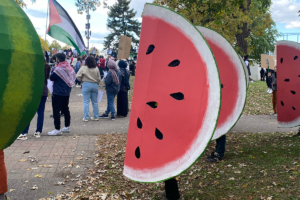
An Interview From the Summer 2016 Issue of Mizna
Biographical Info
Heba Y. Amin is Mizna’s new Curator of Visual Art. This interview was conducted by Lana Barkawi and published in the summer 2016 issue of Mizna (Volume 17.1), which also features a survey of her recent work. Subscribe now to get a copy.

LB: We are living in an interesting cultural moment when it seems the mainstream Western media is rediscovering that politics and art have an important relationship. I’m thinking of the Gulf Labor Artist Coalition, the Guerrilla Girls, Black Lives Matter, and the action you took part in on the set of the television series, Homeland. In response, questions like “what impact can art have on politics” have been arising, as if this is a new idea. What’s your reaction to this?
HA: Today, many artists are dealing with a crisis of conscience. They are grappling with the idea of using art as a platform to voice social injustices. “Social art” has become increasingly prevalent in the context of a world experiencing more and more censorship in media. The debate that is happening now is about whether or not artists have the agency to actually promote change, and whether or not that responsibility should be put on the shoulders of the artist in the first place. Can art in fact make a difference and should we be placing that expectation on art? We find ourselves asking these questions within funding structures and an art economy that are also controversial, and at times an extension of the very issues we are addressing in our work. Who is funding and buying our work?
As a collective of artists, the Gulf Labor Artist Coalition addresses this very point by utilizing their platforms and networks to instigate dialogue and negotiation toward a situation artists (especially from the Arab world) feel complicit in; their aim is to ensure migrant worker rights associated with museum construction in Saadiyat Island, Abu Dhabi. They, like many artists today, are starting to see it as their duty to address social issues that are not being sufficiently challenged, if at all. The aforementioned groups are all using a wide range of creative tactics to address particular social issues. There is no doubt that in some cases creative tactics for social change are really quite effective, but they don’t always work and can sometimes backfire (think Ai Weiwei’s reenactment of 3-year-old Aylan Kurdi’s body washed ashore). In many of these cases it is futile to argue whether or not art can impact politics, but rather we should talk about how art can reach the public, open dialogue, provide different perspectives, and challenge the way people see. Perhaps, to this effect, we can begin to empower people to instigate a movement toward political change.
When we [Amin, Caram Kapp, and Don Karl, a.k.a. Stone, who have come to call themselves, ironically, “the Arabian Street Artists”] “performed” our “Homeland hack,” it was not in the context of an art performance at all. In fact, it was quite instinctual and uncalculated. We were provided with a unique set of circumstances that prompted us to react. Perhaps, with the three of us being involved in the arts in various ways, we were swayed by a certain kind of thinking. It wasn’t until after our hack went viral that it started being framed within the context of art. This is completely fine by me, as it allows our criticism to enter into a realm of debate and discussion; it speaks to the social platform that art has become and allows our hack to live beyond the act itself. I can only see this as being a positive thing toward political change.

LB: What is striking to you about this moment of art activism?
HA: This moment of art activism is different than any other moment because our media constructs have shifted. Social media platforms play a huge role in art activism today not only because of the potential for widespread outreach, but also because of frameworks of participation. The development of platforms that promote citizen journalism have empowered individuals and transformed the way people publicly express themselves. The real power of such tools became evident to me during the Egyptian revolution, when people across the globe participated in an uprising like never before. Today, media activism and tactical media rely heavily on the non-geographies of technology. On the flip side, however, the very platforms being used for democratic expression are the same ones that are incriminating bloggers, activists, and artists who express dissent under authoritarian regimes. Who is held accountable when people are incarcerated for expressing themselves openly? It is important to question the corporate ownership of the freedom of speech.

LB: Can you tell us what it’s been like to be working and teaching in Egypt over last few years, when the situation for activists, journalists, and artists has been so dangerous?
HA: The situation in Egypt is very difficult these days. There is an atmosphere of fear and paranoia that is causing paralysis. Under a zero-tolerance policy toward any form of dissent, Egyptians are experiencing an extreme form of censorship that is sending many people to jail. You can imagine what this does to artists who are reflecting the world around them and how that might impact the kind of work that they are making. In the last few years many arts and cultural institutions have been shut down, some of them voluntarily, because under these conditions, sustainability is nearly impossible. The artistic outburst that coincided with the start of the uprising in 2011, however, relayed the desperate need for creative expression. That is not going to be shut down so easily.
As a professor at the American University, I try to have these discussions with my students. We are afforded a safe and secure place to contemplate these very scary issues, a kind of exploration that could not happen at a public university. Imagine what it must be like for an art student to graduate today and make art in such an environment. My students have expressed their fear quite openly and the fact that they, understandably, cannot afford to take such risks. Can you imagine a future society that is void of critical and creative thinkers? I can’t think of anything more terrifying.

LB: In this election year in the United States, we are living through heightened anti-immigrant, anti-Muslim, and anti-Arab rhetoric and the ensuing upsurge in profiling and violence against innocent people in these communities. The situation in Europe has not been so different. A reality for artists in our community is feeling the burden to respond. I recently heard Naomi Shihab Nye tell a story of a literary magazine that, after having rejected her work for years, actually commissioned a poem from her but stipulated that it be about Donald Trump. She took this in stride, and of course, she wrote a wonderful poem. What do you make of such expectations placed on Arab artists?
HA: The minute we start to put expectations on artists is when we start to lose the possibilities of something else. Unfortunately, in the real world, artists usually do have expectations placed on them in some form or another, be it funding structures or societal constructs. But when it comes to the kind of stories artists tell, we don’t do ourselves a service if we are speaking to the lowest common denominator. We need to be expressing issues that we find to be pressing instead of fitting into somebody else’s misinformed view. I understand fully how this can be a challenge for immigrants and minorities making art—I experienced this myself living in the United States and Europe where I was always forced into an identity that somebody else had defined. The trick is to find strategies and tactics to subvert those constructs.
Given the right situation, this could be a much more powerful approach in conflating the regional divide.

LB: There has been a great deal of global attention on Arab artists over the last decade or so. How is this affecting the situation for artists and their practices?
HA: It is not surprising that there is global attention on Arab artists considering the political stage of the last decade; artistic expression emerging from a population experiencing extreme political and social upheaval would be attention grabbing. This has undoubtedly shifted artistic practice in the region, where many artists from the Middle East are not only reflecting their experiences but are strategically using art to broaden the conversation, provoke debate, and, in some cases, perhaps even attempt to shift realities. With the 24-hour news cycle pushing a particular kind of narrative, artists can provide a much-needed alternative.
In many ways this global attention has positively impacted artists in the region, as many have received international recognition. At the same time, there is a debate about “authenticity” and whether or not foreign funding institutions and media are shaping the way art is being made. However, a relatively recent shift has occurred in reclaiming local narratives and focusing on contemporary art development irrespective of foreign constructs. Reem Fadda’s curatorial concept for the 2016 Marrakech Biennale “Not New Now” addresses Pan Afro-Arab and Afro-Asian unity and looks at “the legacies of decolonization, in addition to its failures, as one of the origins that has inspired contemporary art to embrace incendiarism, criticality, and radicalism.” Large-scale exhibitions like this with predominantly Middle Eastern and African artists allow us to revisit our past on our own terms. Artists from the region are re-addressing recent histories that have been excluded from the books. Sultan El Qassemi, for example, founded the Barjeel Art Foundation to share his significant collection of Middle Eastern modernist works, an era in art history that is only recently being addressed and documented. If it weren’t for projects like this, important periods in cultural production will be forgotten and eventually disappear. Art students in the Middle East, for the most part, are not exposed to contemporary artists from the region and are therefore not developing within the context of their own contemporary art production. As these projects become more publicly documented and integrated into Middle Eastern art discourse, young artists will undoubtedly start to be inspired and influenced by local artistic development instead of looking abroad or back into ancient history. That is the hope anyway.

LB: One of the images we see in these pages is from a new collective you’ve co-founded, the Black Athena Collective. What’s the background of this project and what drew you to it?
HA: The Black Athena Collective is a project I co-founded with artist Dawit L. Petros. We joined forces after we completed another project that we found to be incredibly problematic. We both realized that we needed another space where we could explore, experiment, and find ways to grapple with troubling issues. Our project starts with spatial constructs and political discourses connected to the African continent. The Black Athena Collective’s name is taken from Martin Bernal’s thesis, which questions methodological assumptions embedded within Western historiography. His seminal text suggests that ancient Greece—and Europe in general—was highly influenced by the African continent. We want to explore alternative ways of addressing narratives from South to North and try to uncover this blanket of dominance on narrative, especially as it relates to the architectures of migration. Our format is still open, as we have just recently launched the project; we hope to involve other people, we hope to ask questions, we hope to critique structures in place, we hope to write and visualize and discuss and lead workshops, and let’s see where it takes us.

LB: You have worked with Mizna over the years in so many meaningful ways—as a featured visual artist, an invited filmmaker, and also a behind-the-scenes web whiz. Now you’re taking on the visual arts curation for this journal after Moukhtar Kocache and Aissa Deebi. What’s your vision for the journal’s visual sensibility?
HA: Over the years, Mizna has maintained itself as a place for Arabs by Arabs in a country that has, since 9/11, villified the community in many ways. It provides a significant platform that gives voice to concerns and experiences that affect the Arab community worldwide. There is a very important discussion happening in the art world today about our region. Artists are critiquing and questioning structures, regimes, social injustices, and ideologies in a way that is probably not happening elsewhere. This is incredibly important as we enter into the difficult phase of confronting drastic transformations caused by recent wars, uprisings, and waves of mass migration. Using art as a form of political engagement, artists are narrating contested space and addressing the ramifications of contemporary conditions to cultivate critical analyses of the diverse constructs of the region. My vision for the journal’s visual sensibility is to feature the work of artists who are really challenging previous narratives and proposing a shift in thinking. It is our time to reclaim our own histories, and there are many very capable artists from the Arab and Arab American world whose work explores this in thoughtful and intelligent ways.
Heba Y. Amin is an Egyptian visual artist, lecturer, and visiting assistant professor at the American University in Cairo. She received her MFA at the University of Minnesota and is a DAAD grant recipient, a Rhizome Commissions grant winner, and is short-listed for the Artraker Award. She is the curator of visual art for Mizna, curator for the residency program DEFAULT with Ramdom Association, and co-founder of the Black Athena Collective. She is one of the artists behind the subversive action on the set of the series Homeland that received global media attention.
Amin’s projects are embedded in research addressing the convergence of politics, technology, urbanism, and media. Her work has been shown worldwide with recent exhibitions at Dak’Art 2016 Biennale, the Marrakech Biennale 2016 Parallel Projects, the Museum of Modern Art in Warsaw, Camera Austria, Berlin Berlinale 9th Forum Expanded, the IV Moscow International Biennale for Young Art, the National Gallery of Mongolia, and the Gotlands Museum in Sweden. She has spoken extensively at conferences and events, including Transmediale, re:publica, Laboratory of the Future in Warsaw, and Media Art Histories Conference. She lives between Berlin and Cairo. Amin is represented by Galeri Zilberman in Istanbul.










